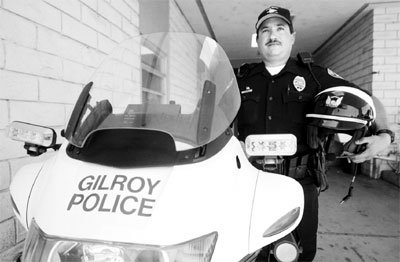Gilroy
– Fewer motorcycle officers patrol Gilroy streets than in Morgan
Hill, though Gilroy is far larger than its neighbor to the
north.
Gilroy – Fewer motorcycle officers patrol Gilroy streets than in Morgan Hill, though Gilroy is far larger than its neighbor to the north. For the past year, two motorcycle officers have curbed speeders in Morgan Hill; up to five stop them in Watsonville, a city slightly larger than Gilroy. Only one Gilroy officer, traffic officer Nestor Quiñones, does the same job here.
Quiñones has requested a second motorcycle to help slow scofflaws, but command staff say tight staffing has prevented them from putting another motorcycle officer on the road. Four Gilroy officers are trained to ride: Quiñones, reserve officer Benjamin Charnota, Cpl. Joseph Crivello and new officer John Ballard. However, only Quiñones and Charnota can currently ride. As a corporal, Crivello can’t be removed from his spot to ride the motorcycle, said Sgt. Jim Gillio; Ballard must clear probation before he can ride. Administrators are waiting on the results of a sweeping $55,000 staffing study, which will re-assess how officers are deployed, to determine if the department can spare a second motor officer, said Gillio.
“Once we get the results back from that,” said he “we’ll be able to make an intelligent decision. The question is, do we want to take an officer out of patrol, or the Anti-Crime Team, or the detectives, to have another traffic officer?”
Equipping and training a motor officer costs roughly $4,000, he said. Training is rigorous: Though Quiñones has been riding a motorcycle for 20 years, he spent three weeks training one-on-one with an instructor before going to a two-week school, then taking a state-mandated test. Motor school drop-outs are common, he said, and officers often fail the test the first time around.
The BMW motorcycle itself costs about $25,000, but advocates say motorcycles actually save police money. In New Jersey, Sgt. Allan Attanasio claims that the added tickets and lower fuel costs saves his department more than $5,200 a year.
“With the enforcement you produce, it pays for itself,” said Quiñones.
The officer couldn’t supply data on whether tickets had increased since he started riding the motorcycle, but said catching violators is far easier on two wheels than four. “It’s three times easier on the motorcycle than in a cruiser. You’re able to turn around quickly, maneuver through traffic – you can work tight residential areas, because you can turn around in one lane.”
In Gilroy, the impact of adding a second motorcycle officer would be “huge,” he added. “They’re most effective when they work in teams.”
Morgan Hill Cmdr. David Swing said his department’s two motorcycles have had a significant impact on the city’s traffic since they hit the streets last year.
“They can enforce traffic laws more effectively than cars,” said Swing. “A car parked on the side of the road is seen by motorists – motorcycles are less conspicuous, and they apprehend the violators.”
In Watsonville, two motorcycles patrol the city every day, one tackling the early commute, one hitting the evening rush hour. For the past decade, the department has had five motorcycles, assigned to individual officers who take the bikes home to maintain at night. One sergeant oversees the division. Lt. Ed Gluhan, a former Watsonville traffic sergeant, calls motorcycles “just a fantastic tool for enforcement.”
“It’s not at all unusual for our motor officers to be first on scene at in-progress crimes, because they can get through town so much easier,” said Gluhan. “Even a patrol car with lights and sirens runs into traffic. They also help on foot pursuits.”
Gilroy does have more motorcycle coverage than one nearby department: Hollister police own a motorcycle, said spokeswoman Rosie Betanio, but no one is trained to use it.
Incentives for motor officers, such as hazard pay, are offered by a few cities. Watsonville gives officers an extra $150 per month, said Gluhan; San Jose also hikes officers’ pay, said Quiñones. Gilroy doesn’t offer a financial incentive for riding the motorcycle: the job is considered a special assignment, and the department doesn’t give extra pay for such assignments. Gilroy isn’t rare: According to a survey of more than 300 police departments, conducted by MotorCops.com, 83 percent of motor officers don’t receive hazard pay.
Nonetheless, Quiñones says there’s ample interest in the job. Several officers have approached him to ask about the motorcycle, and the rigors of the training.
Watsonville has 71 sworn officers and a population of 51,258, according to the state Department of Finance; Morgan Hill has 35, for 38,418 people, and Gilroy has 61 for 49,649 people, according to a January count. Overall, that means Watsonville has the highest staffing per 1,000 people, and Morgan Hill has the lowest.
“Realistically, Gilroy needs four motorcycles,” Quiñones said. “We’ve never had a motor unit, but we’ve got to catch up.”












